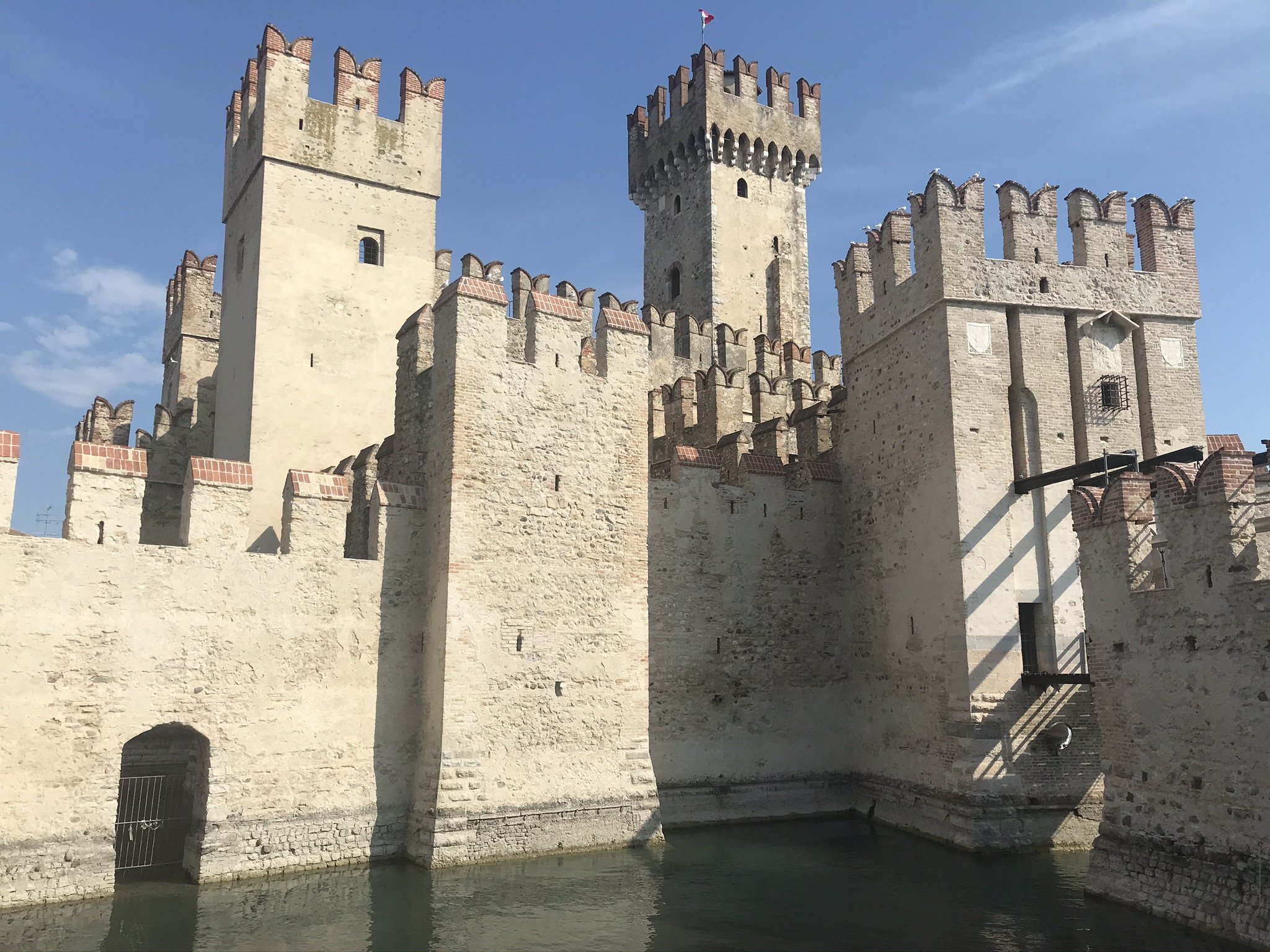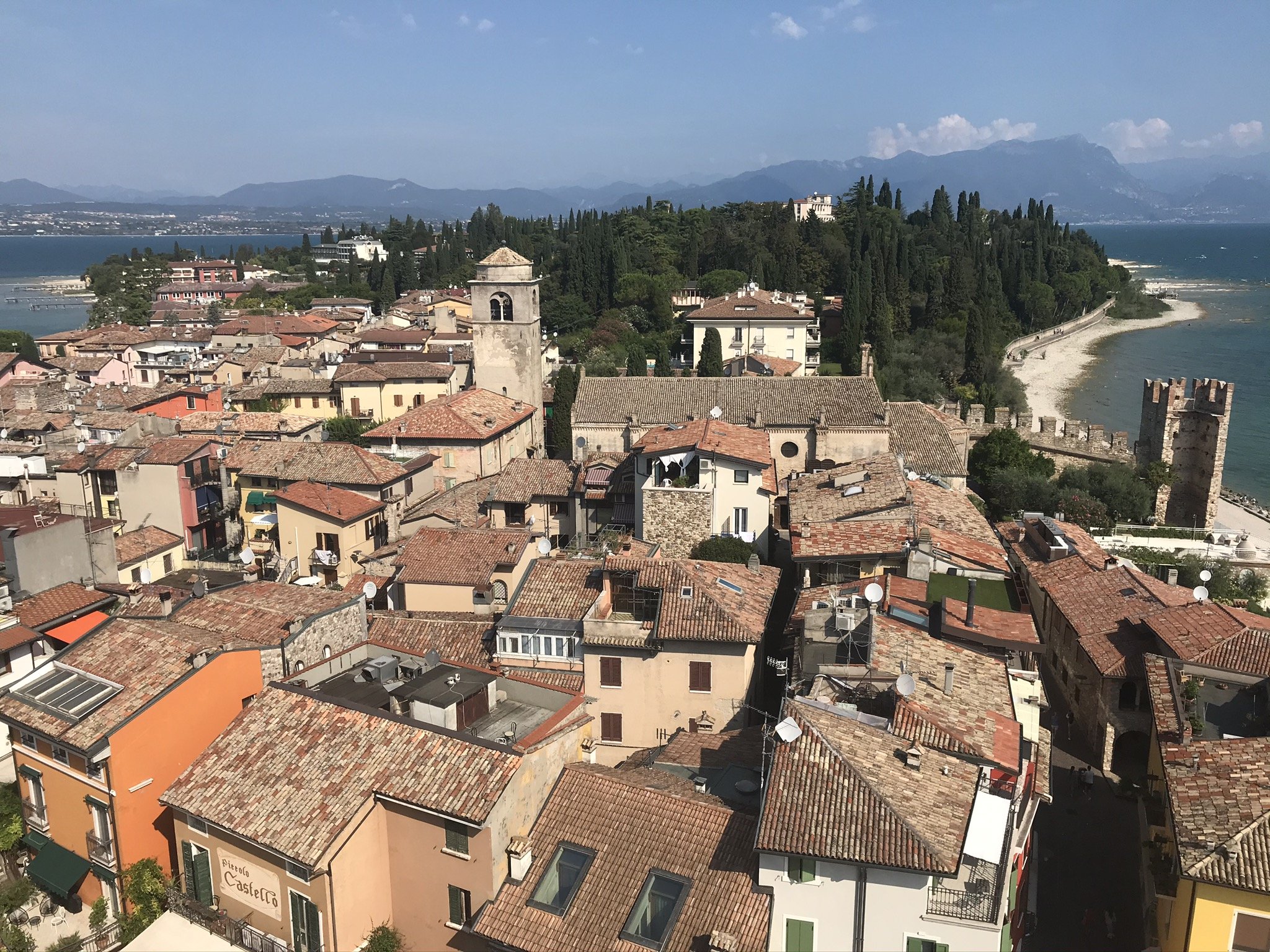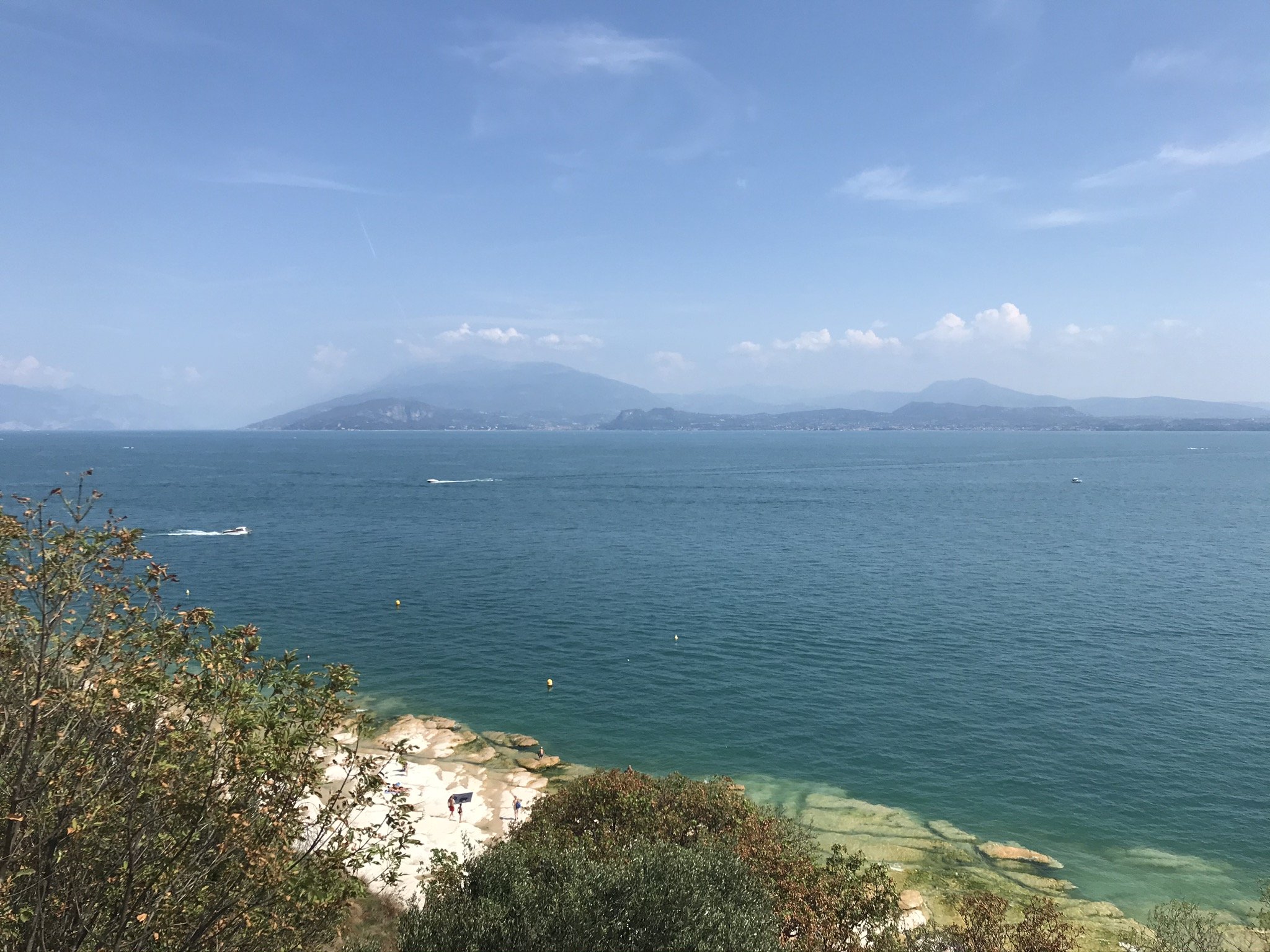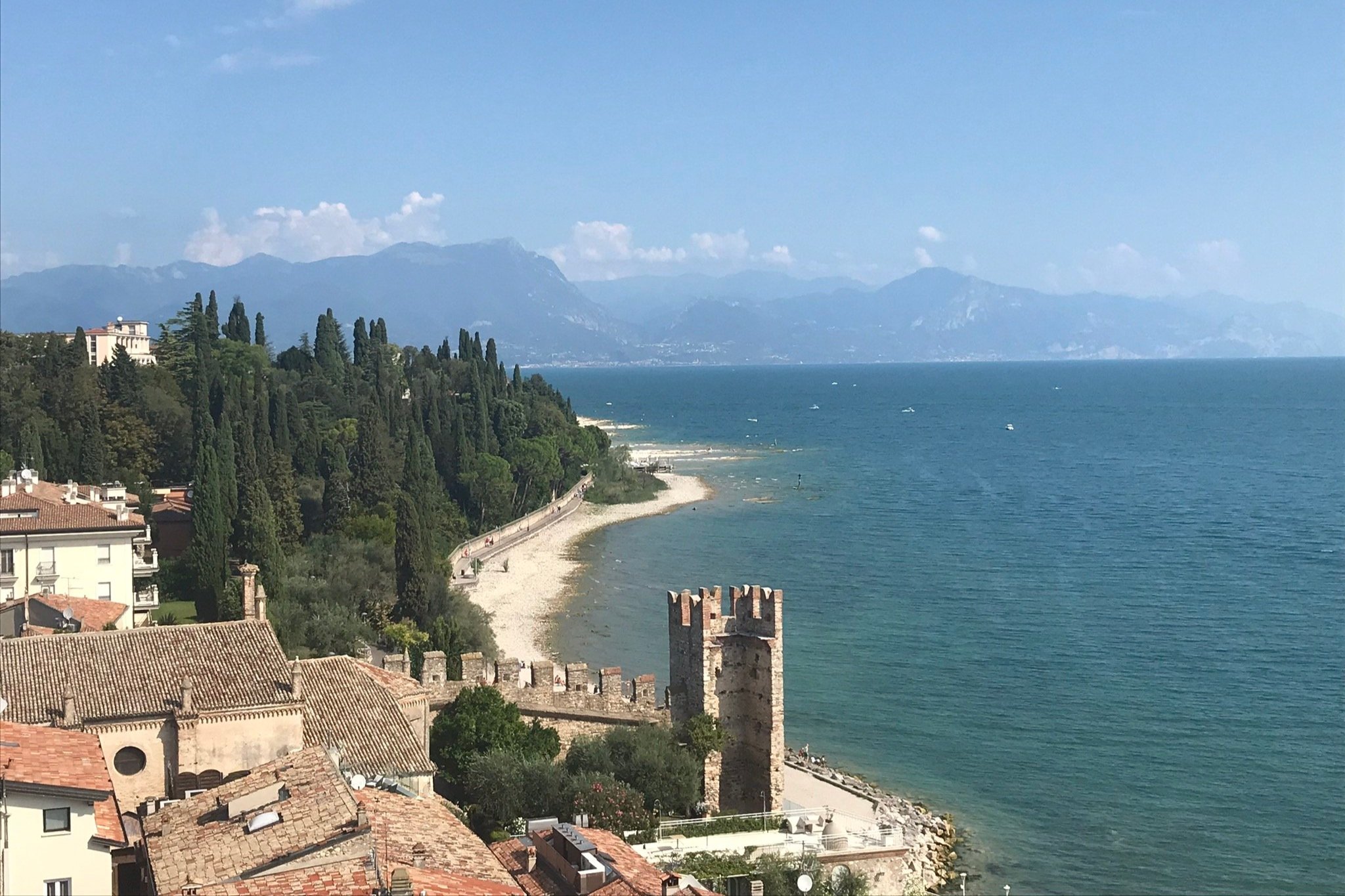Northern Italy is famous for many things, her lakes not least of all. As part-time residence of George Clooney, Lake Como is naturally the most popular, but Lake Garda, or Lago di Garda for the Italians, is the most beautiful and probably has the most to do.
Each lake has its own charm, but Garda Lake has the feeling of a real destination—somewhere you’d fly across the world to see.
Things to do on and around Lake Garda include touring castles, exploring a 2,000-year history from the Romans to the Fascists, endless hiking opportunities, the winner of the most beautiful small town in Italy, exceptional local wines, the biggest amusement park in Italy, and crystal clear waters for swimming.
A week wouldn’t be enough to finish exploring its magnificence. Garda Lake is about forty minutes from Verona, an hour and a half from Milan, and two hours from Venice, placing it on one of the most traveled sections of railway in Italy.
The must-see towns on Lago di Garda
Shaped like a femur bone, there are three different zones on Garda. The ball of the femur is home to the largest towns, and also major railway stations. The two shores of the lake narrow quite strongly as one drives north, and a number of terrifying mountain roads link many of the villages on the heights above.
The mountains above the western shore are one big national park, Parco dell’Alto Garda Bresciano, and at the very end of the lake, one exits the region of Lombardy and enters Trentino Alto Adige.
Between these three zones there are several points you’d kick yourself if you missed.

Limone sul Garda
Nestled under sheer cliffs, Limone sul Garda, literally “Lemon on Garda” is both the northernmost point on Earth where lemons were naturally cultivated in mass, and a prominent Italian gazette’s pick for most beautiful small town, or borgo in Italy circa 2020.
Far at the back of the lake on the western shore, Limone is a beautiful little town cloaked in flowers below towering Enlightenment-era greenhouses for year-round citrus production. If your route is to completely circumnavigate the lake in a car, this makes for an obvious stop.
If you’re planning to visit the town of Riva in Trentino, then Limone is right on the way.




Sirmione
Sirmione is a worthwhile tourist trap on Garda, thanks in no small part to its beautifully preserved Medieval townscape.
Located off the Dezansano train stop, Sirmione lies at the end of a small knife-edge peninsula at the very base of the lake. Here, the centuries lap like waves against the foundations of the city, with Renaissance villas overlooking a Medieval town, overlooked by a Medieval Castle repaired at the birth of the Italian Republic. Famous soprano Maria Callas built a house for herself here.
At the end of the peninsula, a rich Roman noble found it fitting to build himself a lake-front villa, complete with gardened foyer, underfloor heating, and baths.
It’s easy to point to Roman ruins as a tourist attraction, despite them being little more than piles of stone, but the Villa Catula is conserved and presented exactly how looking at Roman ruins should be—namely covered in soft grass and olive trees, without any minders or guards, allowing visitors to walk, touch, and sit on whatever helps them reconnect with the past.
The views of the lake from the Villa are excellent and peaceful as birds flit in and out of the olive tree boughs and grapevines, and when one is finished it’s merely a 5-minute walk to the beach, which in Sirmione’s case is mostly stone slabs.

Tremosine sul Garda
Tremosine sul Garda is a little town on the pinnacles above the lake’s far western shore. Up above the lakefront property the homes become more cozy, and the views truly spectacular.
To reach towns like Tremosine, Priezzo-Sompriezzo, or Pieve, it will require one to drive up the S38, or Strada della Fora which should be done in a smaller car, by whichever member of the group has the hardest nerves.
Going past waterfalls, the route dances up a spider’s-silk road, skimping on neither views nor terror. The road is two-way, and often will require the drivers’ mutual negotiation of the tighter passages that will really demonstrate just how much narrower cars are than we think.
But the destination is worth the journey, as the Terrazza del Brivido offers near 180-degree views of the lake. Above Tremosine lies a network of small roads connecting it to other small towns, which if you are enchanted by the time to arrive in Tremosine, will all be worth seeing.
Honorable mentions
For history lovers, the town of Salò is particularly unique. From 1943 to 1945 Salò was the de facto capital of Benito Mussolini’s Nazi-backed puppet state, the Italian Social Republic, also known as the Republic of Salò.
The local museum preserves this important history.
Peschiera sul Garda is a resort town in the southeastern corner of the lake. This beautiful spot is crowned by the 16th-century fortress and port, Porta Brescia and Porta Verona.
A gondola service will take passengers up the river Mincio, and the whole area is surrounded by the most important white wine-producing wineries in the area.
Things to do on Lago di Garda
Beyond looking inside towns for bemusement, the area around and above Garda Lake is filled with activities.
Most of the content here relates to the western shore of the lake. The eastern shores in contrast are great places for visiting la tenuta, or la cantina—the winery.

The wines of Garda
A hotspot for vineyards, Lago di Garda is known for producing several distinct north Italian wines. The designations come in several layers, making it a bit confusing for your average American wine consumer used to five to six different kinds.
Custoza is a white wine grown in the area around the Mincio River, past the southern shores of the lake near the town of the same name. Custoza wine is a white blend, that’s been described in Italian reviews as “a wine for all meals,” referring to its pairing capacity. Wineries making Custoza wine include the grape varietals known as Trebbiano Toscano, Trebbianello, Garganega, and Bianca Fernanda.
Lugana is a celebrated and historic white wine grown on clay-filled soil sitting atop the level of moraine gravel left over during the carving of Lake Garda by a glacier during the last ice age. Found growing between the cities of Brescia and Verona, Its “roccaforti” or stronghold, is on Garda between the towns of Desenzano, Sirmione, Peschiera, and Pozzolengo.
Another famous wine from Garda is called Bardolino, with some local tourist sites calling it “The Representative” of the region.
It can be found with different characteristics depending on whether one is drinking on the eastern shore or the western shore. Bardolino Classico comes from the Riviera, or western shore, and is made with Corvina, Rondinella, and Molinara grapes, which also make up the northern wine Valpolicella.
Bardolino Chiaretto is actually a rose, and due to very little contact from the skin, it remains extremely light and floral. It is by contrast produced from Bardolino made on the eastern shore.

Gardaland
There’s also a totally legitimate amusement park right on the shores of the lake. Gardaland is one of the largest in all of Italy, and easily rivals the Six Flags, Kings Dominions, or Hershey Parks of the United States.
Perhaps a little more child-friendly than say, Busch Gardens, for example, take nothing away from the more intense rides, which are mostly new, high-tech, and very powerful. It also has its own aquarium.

Hiking
There are dozens of hiking trails above the lake that offer dizzying panoramic views. One look on Google Maps shows the little green hiking man icons all over the area.
However, hiking in Europe is a little different than hiking in the U.S. and some precautions should be noted. First, there’s probably a difference in the average perceived difficulty of a given trail between Americans and Europeans, with the latter seeing everything as probably 1 or 0.5 degrees easier than an American would, just given the topographical differences between the Alps, and mountain ranges in America.
Second, signage is much less thorough. In the U.S., the start of a trail is usually a very thoroughly marked area, and so is the trail itself. In Europe, often there are only small signs at the start of the trail, and maybe one other in the middle somewhere. Furthermore, European hiking trails will also make use of paved roads, offering a confusion as to when and where one is supposed to leave the road and return to a trail.
For this, it’s smart to use local mountaineering blogs, like this one here that offers descriptions on 17 different trails. Unfortunately, that means relying on Google Translate to change over the Italian. But don’t be dissuaded, a look at the pictures shows it’s entirely worth the effort. WaL
PICTURED ABOVE: Sirmione, Lake Garda. PC: Andrew Corbley ©
If you think the stories you’ve just read were worth a few dollars, consider donating here to our modest $500-a-year administration costs.
Continue exploring this topic — Northern Italy — The ‘Fungiatt’ Northern Italy’s Mushroom-Mad Mountain Men
Continue exploring this topic — Italy — In Northern Italy Lago d’Orta is as Beautiful as It is Unknown
Continue exploring this topic — Northern Italy — Two Days in Siena — According to Artist Sandra Petreni



